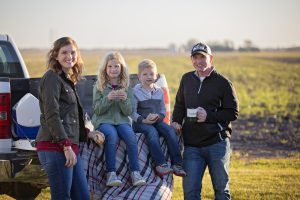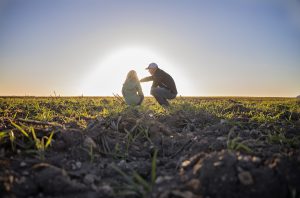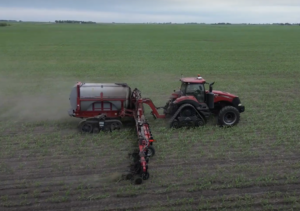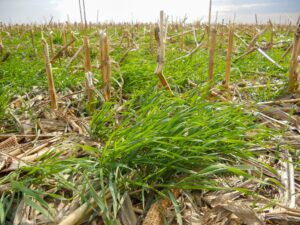By: 4R Plus
February 2019

While Julie Kenney uses her role as Iowa Deputy Secretary of Agriculture to encourage farmers to utilize 4R Plus practices to improve soil health and water quality, her husband Mark, a fifth generation corn and soybean farmer in Story County, implements the practices on their farm. They wants to do what’s right on their farm and want others to learn as much as they can about conservation and nutrient stewardship practices and utilize public and private-sector cost-share opportunities.
“In this role I am able to take the experiences from our farm and apply them to the work we do across the state. Conservation and water quality are a major focus for Secretary Naig and the Iowa Department of Agriculture and Land Stewardship,” said Julie. “There are numerous practices farmers can use within fields, as well as edge-of-field practices, to make sure the soil and water is protected now and in the future.”
On their own farm the Kenney’s plant cover crops, utilize conservation tillage, plant native grasses in buffer strips and use data from soil tests to target fertility applications. “We are fortunate to live in a time with access to data. It’s our responsibility as farmers to use that data to see what’s happening in our fields,” said Mark.
Every two years they soil sample on two-and-a-half-acre grids. “It has opened my eyes tremendously to the holding capacity of our soils for available nutrients and rainfall,” said Mark. “There’s definitely an economic benefit of allocating dollars for soil sampling as the plant is going to take in only what it needs and no more. The testing has allowed us to realize we can reduce our P and K applications and switch some of those dollars to conservation practices.”

As a result, cover crops have become a large part of their plan to improve soil health and much of their corn acreage is dedicated to growing seed corn. “A big advantage of growing seed corn is the early harvest, which gives us time to seed oats as a cover crop so it’s well established with good growth,” said Mark. “Cover crops protect the soil from wind erosion and scavenge nutrients to make it available for the next year’s crop.”
Mark says getting started with a new practice is the biggest obstacle. He has learned a lot about cover crops from attending meetings and field days and encourages farmers to adopt a long-term view of this practice. “I asked a lot of questions when I decided I wanted to learn about cover crops,” he said. “After I started planting cover crops I realized I should have started this a long time ago.”
To assist in the knowledge-gathering process, Julie encourages farmers to visit their local USDA service center. “IDALS and NRCS staff will make sure you are connected with the right funding sources and are equipped with experts to help you determine what practices would be best to add to your farm,” she said.
“We continue to see farmers across the state implementing conservation practices because it’s the right thing to do and there are in-field benefits,” said Julie. “I’m proud of the work we have done so far in the state and I want to use my role working with Secretary Naig to challenge farmers to learn how we can all do our part to protect Iowa’s valuable natural resources.”



